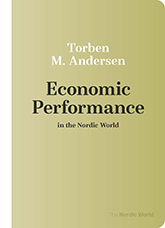|
Economic Performance in the Nordic World
Torben M. Andersen
Nordic World
Copublished with Aarhus University Press
The Nordic countries stand out in international comparisons for having both high living standards and low inequality. The welfare state and public sectors are large and the tax burden is high. How have these countries managed to achieve such favorable economic performance?
Economist Torben M. Andersen shows how the Nordic model rests on two pillars: the social safety net, which offers income compensation to the majority of those unable to support themselves, and the provision of services like education, childcare, and healthcare to all. The Nordic model can be characterized as one of employment, since its financial viability rests on a high labor participation rate with few working poor.
Andersen lays out the structure of the model and highlights factors important for understanding its economic performance. He then looks into specific policy areas based on Denmark’s experiences regarding labor market policies (flexicurity), pension systems, and preparation for an aging population; and addresses the challenges arising from new technologies and globalization.
Torben M. Andersen is a professor in the department of economics and business economics at Aarhus University. He has provided policy advice to the EU Commission and countries including Denmark. His work is published extensively and in internationally recognized journals as well as books.
|

Larger images
May 2021
120 pp. 5.5 x 8.5
|

